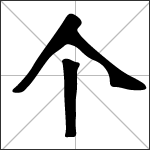Measure Words (量词) Posted by Stephen on Jun 30, 2011 in Vocabulary
 When I taught English in China, one of the easiest lectures was on English articles–simply because there are only three of them (a, an and the). However, when discussing the use of “this” 这 and “that” 那, some problems would arise. Some students would say things like: “this the ball is red” or “that a school is where I study”. At first, it was a bit confusing, and I tried to explain that there is no need for an article when using “this” or “that”, but some students still weren’t grasping it. The problem, was a fundamental difference between English and Chinese, namely, the use of measure words or 量词 (liàng cí).
When I taught English in China, one of the easiest lectures was on English articles–simply because there are only three of them (a, an and the). However, when discussing the use of “this” 这 and “that” 那, some problems would arise. Some students would say things like: “this the ball is red” or “that a school is where I study”. At first, it was a bit confusing, and I tried to explain that there is no need for an article when using “this” or “that”, but some students still weren’t grasping it. The problem, was a fundamental difference between English and Chinese, namely, the use of measure words or 量词 (liàng cí).
Measure words are Chinese “classifiers” that relate to an object or noun. Yet unlike English, where the classifiers (some people call them modifiers) are quite simple, the Chinese language takes a very specific and lengthy approach to modifying nouns. For foreigners learning the language, it’s one of the least enjoyable parts of Chinese, requiring rote memorization above all else. That being said, many of the measure words relate to the type of noun or object in question, harking on physical attributes or lump-categories.
The most basic measure word, 个 (gè) is used when dealing with people or individual things. For example: 两个人(two people). Yet for other objects and nouns, distinctions are made within the Chinese language, that classifies them based on appearance or groupings.
For example: books generally use the classifier 本 (běn) as it is associated with works of literature. Flat objects use 张 (zhāng), as in the case with tables and desks. Animals use 只 (zhī), although it depends on whether or not they are domesticated, while machines and mechanical things use the form 台 (tái). For landmarks, large buildings and mountains we use 座 (zuò). However, there are always exceptions to the rule as 条 (tiáo) can be used for long and flexible things, one-dimensional things, or abstract items like news reports…confusing yet?
Follow along with some video examples of measure words:
I could post endless pages about specific classifiers and measure words, but that would be rather redundant. If you want to learn classifiers and measure words, you simply have to hit the books and memorize the characters. It isn’t fun, but you build exponentially as you go. For those willing to do so, click here for an extensive wiki list on classifiers.
The last thing to mention about measure words, is the use of them within numerical entities and when using “this” and “that”. Within Chinese language, any use of “this” or “that” is prefaced with a measure word. For example: 这张桌子 (this table) or 那个人(that person). When using numbers, this is often the case, but not always the rule. When numerals are involved, often the measure word or classifier is part of the verb object (for example: with 杯子[bēi zi] or cup you can say 两杯 instead of 两个杯子).
In this sense, the classifier actually takes on the meaning of the object or verb in question, so to shorten the phrase, the noun (obejct) is dropped. Example: How much does this cost? “多少钱” Answer: 五块 (five kuai) instead of saying 五块钱 (five kuai yuan).
I’ll admit that the sheer volume and breadth of measure words is difficult to learn as a native English speaker (much like prepositions are immensely difficult for Chinese natives to learn in English), but that’s the way the language is set up.
Luckily for us 老外, since the 1940’s and following the simplification of Chinese characters (简体字), there has been a trend to move away from many of these qualifiers in vernacular Chinese(白话 bái huà).
Often you’ll hear the 个 measure word inserted in phrases for use of ease. Technically, it’s not correct, but it does make conversation much easier, especially when you forget the measure word for a domesticated horse, that is actually a “horse-like-donkey”.
Follow Steve on twitter: @seeitbelieveit

Build vocabulary, practice pronunciation, and more with Transparent Language Online. Available anytime, anywhere, on any device.
About the Author: Stephen
Writer and blogger for all things China related. Follow me on twitter: @seeitbelieveit -- My Background: Fluent Mandarin speaker with 3+ years working, living, studying and teaching throughout the mainland. Student of Kung Fu and avid photographer and documentarian.




Comments:
andy:
i’m chinese…………cooool